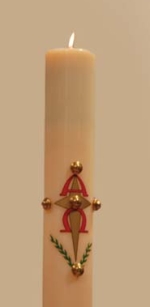 Contributing editor Melinda R. Heppe reflects on an Easter vigil that provides the time, space, and focus to help participants connect with the divine.
Contributing editor Melinda R. Heppe reflects on an Easter vigil that provides the time, space, and focus to help participants connect with the divine.
One early issue of In Trust included a cover story about a board retreat. Interviewees from the school that we featured were very happy with their retreat activities and proud of what they had accomplished.
On the other hand, the focus group we gathered to evaluate the magazine was moved to giggles by the whole notion, and especially by our cover photo.
Some of the laughter was inspired by different interpretations of what constitutes a retreat. I've noticed that some schools haul their board off to the woods somewhere, and then conduct business as usual. Others stay at home, but set aside time for seeking deeper motivations.
We're not big retreatants here at St. John's Church. But there are some times that stand apart, that reconnect us with ourselves, with one another, and with our purpose. They do the things a good retreat does, whatever we call them. Chief among these is the Easter vigil.
The vigil has been through some changes. We used to have it at midnight, and we ran through the whole business in an hour or so. But then we couldn't drum up any enthusiasm for getting out of bed the next morning.
So we started earlier — as soon as the Saturday night AA meeting was over — but we found we still needed more time.
Eventually it became an all-night affair. The "new fire" gets lit first. We never start the blaze with a match, so there are inevitable discussions about the right tools to use. Now that the church's Cub Scouts are becoming Boy Scouts, getting the fire started shouldn't be a problem. (No more propellants in the straw!)
The service of readings goes on all night, one reading every 45 minutes or so with meditation in between. There's always someone — sometimes a fairly large group — awake upstairs in the church, holding candles while they pray. As the night goes on, more and more people fall asleep in odd corners of the church.
What goes on in the hall downstairs varies from year to year. There's usually a movie (we've done everything from VeggieTales to Jesus of Montreal, depending who's present), crafts (themed to decorating the church in the morning), deep discussion, and nibbling (with friendly banter about when exactly Lenten fasts can be broken).
As the night goes on, the church is gradually decorated — still in darkness save for the paschal candle and the candles burning in the pews. Some people slip home to dress up; others stay in their pajamas.
At dawn, worship continues with baptisms or affirmation of baptismal vows. The lights go on, and the volume goes up. We continue with testimonies about what new life has meant for various people. The sung and shouted Alleluias make up for those we omitted during Lent. We celebrate the Eucharist. And then we have an extravagant breakfast and go home.
At some point, we are all of us at once tired and punchy and overwhelmed and joyful.
It feels a bit like the first Easter.
Well, there you have it. It's no blueprint for anyone else. But somehow, somewhere, your board must figure out how to make space for people to connect with the eternal.
A retreat, like the Easter vigil, can offer people the time to consider what's truly important — indeed, what gives life meaning. When you set aside time and space, leave room for the Spirit. There are lessons to be learned, there is work to be done — some work of which you are not even aware. Sometimes, though, it is good to be lifted above our agenda and into our calling.